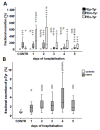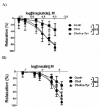Role of Tyrosine Isomers in Acute and Chronic Diseases Leading to Oxidative Stress - A Review
- PMID: 26785996
- PMCID: PMC4997921
- DOI: 10.2174/0929867323666160119094516
Role of Tyrosine Isomers in Acute and Chronic Diseases Leading to Oxidative Stress - A Review
Abstract
Oxidative stress plays a major role in the pathogenesis of a variety of acute and chronic diseases. Measurement of the oxidative stress-related end products may be performed, e.g. that of structural isomers of the physiological para-tyrosine, namely meta- and ortho-tyrosine, that are oxidized derivatives of phenylalanine. Recent data suggest that in sepsis, serum level of meta-tyrosine increases, which peaks on the 2(nd) and 3(rd) days (p<0.05 vs. controls), and the kinetics follows the intensity of the systemic inflammation correlating with serum procalcitonin levels. In a similar study subset, urinary meta-tyrosine excretion correlated with both need of daily insulin dose and the insulin-glucose product in non-diabetic septic cases (p<0.01 for both). Using linear regression model, meta-tyrosine excretion, urinary meta-tyrosine/para-tyrosine, urinary ortho-tyrosine/para-tyrosine and urinary (meta- + orthotyrosine)/ para-tyrosine proved to be markers of carbohydrate homeostasis. In a chronic rodent model, we tried to compensate the abnormal tyrosine isomers using para-tyrosine, the physiological amino acid. Rats were fed a standard high cholesterol-diet, and were given para-tyrosine or vehicle orally. High-cholesterol feeding lead to a significant increase in aortic wall meta-tyrosine content and a decreased vasorelaxation of the aorta to insulin and the glucagon-like peptide-1 analogue, liraglutide, that both could be prevented by administration of para-tyrosine. Concluding, these data suggest that meta- and ortho-tyrosine are potential markers of oxidative stress in acute diseases related to oxidative stress, and may also interfere with insulin action in septic humans. Competition of meta- and ortho-tyrosine by supplementation of para-tyrosine may exert a protective role in oxidative stress-related diseases.
Figures













References
-
- Gutteridge J.M. Hydroxyl radicals, iron, oxidative stress, and neurodegeneration. Ann. N. Y. Acad. Sci. 1994;738:201–213. - PubMed
-
- Paravicini T.M., Touyz R.M. NADPH oxidases, reactive oxygen species, and hypertension: clinical implications and therapeutic possibilities. Diabetes Care. 2008;31(Suppl. 2):S170–S180. - PubMed
Publication types
MeSH terms
Substances
LinkOut - more resources
Full Text Sources
Other Literature Sources
Medical
Miscellaneous

